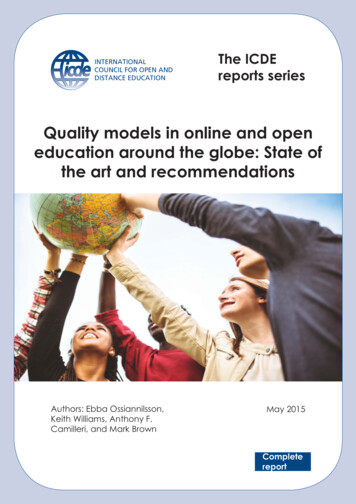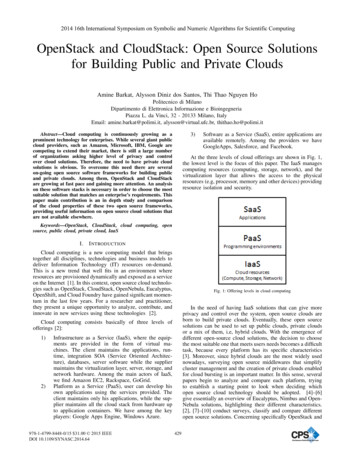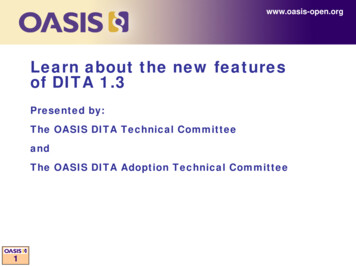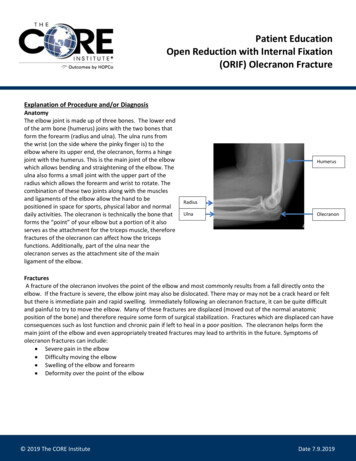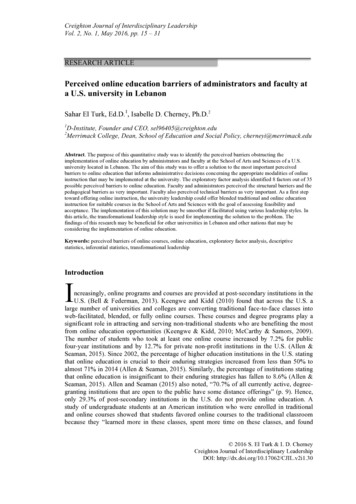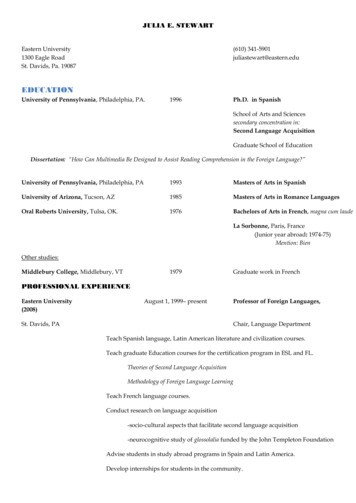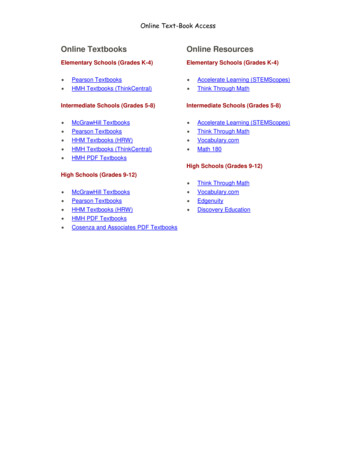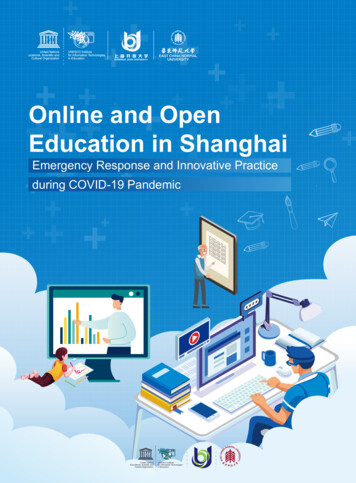
Transcription
Online and OpenEducation in ShanghaiEmergency Response and Innovative Practiceduring COVID-19 PandemicUnited NationsEducational, Scientific andCultural OrganizationUNESCO Institutefor Information Technologiesin Education
Online and Open Education in Shanghai:Emergency Response and Innovative Practice during COVID-19 PandemicPublished in 2020by the UNESCO Institute for Information Technologies in Education8 Kedrova St. (Bldg. 3), 117292 Moscow, Russian Federation UNESCO IITE 2020This publication is available in Open Access under the Attribution-ShareAlike 3.0 IGO (CC-BY-SA 3.0 IGO)license /). By using the content of this publication, theusers accept to be bound by the terms of use of the UNESCO Open Access Repository -en).The designations employed and the presentation of material throughout this publication do not imply theexpression of any opinion whatsoever on the part of UNESCO concerning the legal status of any country,territory, city or area or of its authorities, or concerning the delimitation of its frontiers or boundaries.The ideas and opinions expressed in this publication are those of the authors; they are not necessarilythose of UNESCO and do not commit the Organization.Cover photo: Graphic Design (cover) – SOU
Online and Open Education in Shanghai:Emergency Response and Innovative Practice during COVID-19 PandemicJune 2020Institute for Information Technologies in Education, UNESCOShanghai Open UniversityEast China Normal UniversityJune,2020
PrefaceShanghai is a large metropolis in China with a population of over 24 million, including about 2.2 millionstudents at different levels and millions of learners in informal and formal education institutions. Whenthe COVID-19 pandemic hit the city, all schools, universities, and various training and learningcenters in Shanghai were forced to close for the first time. The city was like all other cities in Chinaand worldwide, shifting from face-to-face learning to home-based online learning as the only option.As a member of the UNESCO Global Network of Learning Cities and a metropolis with a dramaticallydeveloping economy and technology, Shanghai has established an outstanding online and openeducational system that covers different levels of education. Nevertheless, the COVID-19 pandemicbrought unprecedented challenges and huge pressure related to the prevention of learning disruptionin this large city with substantial differences and diversified demands in education across its urbanand suburban districts.This Report aims to document the emergency response and innovative experience accumulated byShanghai in protecting students' safety and ensuring that learning is undisrupted during this challenging period. The aim is to describe the immediate and systematic actions of the local government, theinnovative and inspiring practices of teachers, students, parents and education administrators, andthe active and passionate engagement of the public, both learners and learning supporters. The mostdynamic parts of this Report are the 18 case study examples collected from the different educationalcategories of preschool education, primary and secondary education, higher education, vocationaleducation, and technical training, and formal and informal learning for parents, the elderly and thepublic. It is a tiny part of Shanghai's experience in combating the pandemic. However, these examples reflect the collective yet individualized approach in different situations and for different groups oflearners, including rural areas, students with special needs, and psychological issues in the timeswhen classes disrupted.The UNESCO Institute for Information Technologies in Education (IITE) drafted the Report in partnership with Shanghai Open University (SOU) and East China Normal University (ECNU). It presents anoverview and summary of emergency response and actions taken by local government, schools,universities, and public engagement, focusing on different levels of education. The impact of theCOVID-19 pandemic on education extrapolated to outline lessons learned and recommendations forenhancing the resilience of education in the future from experts' perspectives.1June,2020
As the world is still in the pandemic crisis, we hope that this Report would be helpful to municipalauthorities and all other education stakeholders, including administrators, school and university teachers, students, parents, and general public, facing similar challenges all over the world. We hope thatthe innovative experience and lessons learned in Shanghai will promote online and open educationwhen the pandemic is over and contribute to the development of more resilient education systems.On behalf of the UNESCO IITE, I would like to thank the Chinese National Commission for UNESCOand Shanghai Municipal Government for their kind support to the preparation of this Report. Oursincere thanks and appreciation go to the two partner universities, Shanghai Open University (SOU)and East China Normal University (ECNU), for their passionate engagement and excellent contribution. Most parts of this Report have been accomplished by the two teams, the SOU team with leadership of Professor Wen Yuan, the President of the University, and the professional team of ProfessorXiaoqing Gu at ECNU. We are also very thankful to the teachers, students, school and university leadership who have inspired us with their innovative experience and helped us collect first-hand materialsfor the case studies. Without their contribution, this Report could not have been completed in such ashort time.Dr. Tao Zhan,DirectorUNESCO Institute for Information Technologies in EducationJune,20202
AcknowledgmentWe would like to thank the following individuals and organizations for their valuable contributions tothis publication:Shanghai Open UniversityShanghai Engineering Research Center of Open Distance Education of Shanghai Open University.East China Normal UniversityShanghai Engineering Research Center of Digital Education Equipment of East China Normal University.AuthorsProfessor Hong Wang, Professor Jun Xiao, Ms. Mengying Cao, Associate Professor Chen Yang,Professor Songhua Wang, Associate Professor Haihong Peng, Associate Professor Jun Fan,Mr. Yongjin Guo, SOU, ChinaProfessor Xiaoqing Gu, Dr. Yanyan Sun, Dr. Hua Du, ECNU, ChinaDr. Li Yuan, Centre for Educational Technology, Interoperability and Standards (Cetis) / Wolearn, UKDr. Svetlana Knyazeva, Dr. Natalia Amelina, Mr. Denis Kapelyushnik, UNESCO IITE, Russia.Case Study Material SupportersIntroduction section: Zhihui Wei, Xiaojuan Yu, Shanghai Open UniversityPreschool Education Section: Aiming Li, Yiye Ying, Shanghai Open University; Hongmei Mao,Preschool Education Information Department of Shanghai Education Commission Information Center; YiXin, Shanghai preschool education network; Tianlei Li, Shanghai Education TV Station; Sujing Zhu, BingXu, Yu Zhang, Soong Ching Ling Kindergarten.Basic Education Section: Bin Xu, Education Bureau of Jinshan District; Educational Department ofShanghai Municipal Government; Education Bureau of Zunyi; Jun Shen, Qiangwei Primary School;PingJin, Jinshan No. 2 Experimental Primary School; Qin Zhang, Dong Li Feng Mei Kang Jian School;Professor Fei Zan, East China Normal University; Weilan, Wang, Shanghai Xuhui Special EducationGuidance Center; Yan Li, Education Bureau of Pudong Discrict; Yonghong He, Education Bureau ofMinhang Discrict; Yuanyuan Yao, Shanghai Teacher Training Center at SMEC; Yue Zhu, Qibao HighSchool; Xiaoyan Shi, Yuannan Middle School; Xiaodong Chen, Education Bureau of Xuhui Discrict;Weibin Xu, Ziqun Qi, Zhoupu Yucai School.3June,2020
Higher Education Section: NYU Shanghai; Hua Liu, Lingxu Yu, Shanghai Open University; EastChina Normal University.Vocational Education Section: Lei Meng, Yanyun Zhong, Zhenzhi Zhai, Shanghai Open University.Lifelong Education Section: Haizhen, Ding, Shanghai Changning District Community College;Huanxin Zheng, Zhihua Liang, Hongbin Jia, Shanghai Open University; Min Wang, Shanghai Universityfor the Elderly.Contributor for Translation and Revision:Dr.Stephen Powell, Manchester Metropolitan University, U.K.Last but not least, we would also like to thank the following persons/schools for theircontribution in the ReportLamei Wang, Minjun Ji, Shanghai Open University; Yingzi Gu, Huan Wang, Shanghai ExperimentalKindergarten; Baoqi Shen, Shanghai Songyin Middle School; Changhong Qiao, Minhang High Schoolof Science and Technology affiliated to ECUST; Chaoqun Huang, You Ai Experimental Middle Schoolaffiliated to Minhang Education Institute ; Cuiying Sun, Jinshan Zhujing No. 2 Primary School ; JibiaoGuo, Shanghai Qibao No. 2 Middle School; Ping Teng, Shanghai Gao An Road Primary School; QianFang, Shanghai Fushan Foreign Language Primary School; Suhua Peng, Shanghai Luoxing MiddleSchool; Shengchun Wang, Nanyang Middle School; Tao Jin, Shanghai Jianshan Middle School;Xuefeng He, Minhang Experimental Primary School; Yong Chen, Shanghai World Foreign LanguageMiddle School; Zhengmin Wang, Shanghai No.2 Secondary School.June,20204
ContentsPreface1Acknowledgment3Chapter 1. Shanghai in Action to Ensure Education Continuity61.1 Policy and strategies to ensure the “Disrupted Classes, Undisrupted Learning” in Shanghai1.2 Responses from different levels of education in Shanghai1.3 Innovative educational programs for the publicChapter 2. Preschool Education: Online and TV Programs SupportingParents and Children Home LearningBest Practice Case StudiesCase 1. High-Quality Online Resources for PreschoolsCase 2. Flagship Children Programs on TelevisionCase 3. Special Online Courses for ParentsCase 4. Online Learning Community for ParentsChapter 3. Basic Education: Individualized Solutions for Different Levelsand Groups of StudentsBest Practice Case StudiesCase 1: Excellent Online Courses from Best TeachersCase 2: Supporting Students in NeedCase 3. Online Training for Teachers in Undeveloped ProvincesCase 4: Supporting Students with Special NeedsCase 5: Innovative Remote Learning in SchoolsChapter 4. Vocational Education: Scaling up Online Practical Training forStudents and ProfessionalsBest Practice Case StudiesCase 1: Integrating Different Resources to Support Online LearningCase 2: Innovative Online Labs and Online Practice TrainingCase 3. Online Business Training and Professional DevelopmentChapter 5. Higher Education: Leading Changes in Online Education forCollege StudentsBest Practice Case StudiesCase 1. Flexible Online Learning for Graduate StudentsCase 2: Flexible Use of Online Platforms and Tools to Reach Students GloballyCase 3: Online Innovation and Entrepreneurship Training CampChapter 6. Lifelong Learning: Online Learning Community and FlexibleLearning for the 444464850Best Practice Case StudiesCase 1: Building an Online Learning SocietyCase 2: Radio Class in Mobile Cabin HospitalsCase 3: Flexible Learning for Elderly50Chapter 7. Challenges and Future Impact575053557.1 Major challenges in the online and open education in Shanghai7.2 Future ImpactReferences5760635June,2020
Chapter 1.Shanghai in Action to Ensure Education ContinuityShanghai is the largest city in China, with a population of more than 24 million. It is considered the nation'sleader in education. More than 1.43 million primary and secondary school students, 100,000 secondaryvocational students, and over 700,000 higher education students had to switch to online learning duringthe COVID-19 pandemic (Shanghai Municipal Education Commission, 2020). Guided by the ChineseMinistry of Education, the Shanghai Municipal Education Commission maintains a relatively high autonomy for developing localised policies, implementation, and financing strategies, and setting specifictargets. The Commission takes the primary responsibility for the financing and provision of affiliatedbranches of higher education. Local educational authorities in the districts (in urban areas) and counties(in rural areas) are responsible for the financing and provision of preprimary education, the nine-yearbasic education, and senior secondary education. Although on the whole, the Shanghai education systemis considered to be an advanced one, there are still issues to address in areas, such as equitable accessto education, uniformly high quality of education and a digital divide between schools and districts that canaggravate digital exclusion.Moving teaching for this large number of students from campus-based face-to-face to home-based onlinelearning has been a significant challenge. Universities, schools, educators, and parents have had todevelop new approaches to support students' learning, organize online teaching and identifying usefuland exciting online resources, and provide online support for students studying at home.1.1 Policy and strategies to ensure the “Disrupted Classes,Undisrupted Learning” in ShanghaiSchools and universities have been closed in China to prevent the spread of the COVID-19 virus sinceJanuary 2020. Chinese Ministry of Education launched an initiative entitled “Disrupted Classes, Undisrupted Learning” (Huang et al., 2020). In response to the COVID-19 pandemic, the Shanghai MunicipalEducation Commission (SMEC) issued the "Notice on Effective Prevention and Control againstCOVID-19 in Schools" on January 23rd, 2020. This notice stated that the management of educationactivities should be strengthened during the pandemic, and plans should be developed to mitigate theworst effects of educational institutions' closure and ban on physical attendance. Shanghai’s educationefforts to contain the pandemic are shown on the time axis in Figure 1.June,20206
Timeline of the Shanghai’s efforts in education sector to contain the pandemicJan 23rdNotice on Effective Prevention and Control against COVID-19 inSchools issued by Shanghai Municipal Education and HealthCommission and SMEC; give great prominence to epidemic containment; fortify health education and prepare prevention tips; thoroughlyinvestigate the situation and implement classified management;strengthen the management of education activities to reduce risks;formulate work plans and get prepared for school reopening; enhancethe on-duty system to ensure smooth communicationJan 24thNotice on Implementing Student Financial Assistance Citywideduring the Epidemic issued by SMEC and Shanghai FinanceBureauJan 26thNotice on Further Strengthening Covid-19 Containment inShanghai issued by CPC Shanghai Municipal Committee andShanghai Municipal People's GovernmentJan 27thA notice of SMEC regulated that all schools were not allowed toopen before February 17, but should prepare for the delayedreturn to schoolsJan 31stSMEC issued A Letter to All Primary and Secondary SchoolStudents and Their Parents and put forward three demands: a)Understand the epidemic situation objectively and scientifically; b)Cooperate for epidemic containment, and c) Reasonably arrangewinter vacation life and not allowed to return to school early.Feb 5thSMEC: all schools in Shanghai were not allowed to open untillate February. During the hiatus, schools were required to providestudents with learning materials and suggestions, maintaincontact and interaction with students, and reiterate that alltraining institutions and childcare institutions should suspendoffline services until the end of February.Feb 7thPolicies and Measures of Epidemic Prevention and Control toSupport the Steady and Healthy Development of ServiceBusinesses in Shanghai issued by Shanghai Municipal People'sGovernment.Feb 10thShanghai issued Notice on Subsidizing Online Vocational Educationfor Employees of Enterprises Hit by the Epidemic in Shanghai;Shanghai’s education sector held a conference on epidemicprevention and control and put forward three principles: first,the safety of teachers and students should be put in the first priority;second, think about worst-case scenarios; and third, coordinate forjoint epidemic containment.Feb 13rdNotice on Strengthening School-Business Collaboration andManaging Well Practice and Internship Programs of College Studentsduring the Epidemic issued by 6 authorities including SMECFeb 17thSMEC: as for different groups of students, organize 40 experts toform psychological counselling groups to intensify their counterpartsin colleges and districts for the underaged, publish the Handbook ofMentality Training for Primary and Secondary School Students andtheir Parents in COVID-19 Outbreak, and offer a series of mentalaccommodation courses. Hotlines in 16 students’ psychologicalcounselling centers across Shanghai have been run round the clock,so have been in 55 colleges and universities, plus online tutoring.Feb 18thSMEC: from March 2nd onwards, the city's primary and secondaryschool students would all start to attend the "Class in the Air".Shanghai's primary and secondary schools and colleges kicked offonline education in March.SMEC and Shanghai Bureau of Human Resources and SocialSecurity issued the Notice on Fighting the Epidemic and ManagingCollege Students’ Employment for 2020Feb 21stShanghai Municipal Educational Examinations Authority: postponethe 76th Shanghai’s online registration of higher educationself-learning examination scheduled initially from February 24th toMarch 2nd.Feb 25thFrom 8: 20 am to 9: 00 am on February 25th, the first pilot classfor online education of Shanghai's primary and secondaryschools, "Public Class for Primary and Secondary SchoolStudents on Epidemic Containment," was broadcast.Feb 28thSMEC: before the epidemic was contained,kindergartens were not allowed to open without approval, andchildren would not charge.Shanghai’s Joint Meeting Office on the ComprehensiveManagement of Training Market issued a notice requiring alltraining and childcare institutions to continue to keep offlineservices closure from March 1st.Figure 1.The Shanghai government action in January and February 2020.7June,2020
1.1.1 Key actions to ensure education continuityTeaching children about CoronavirusShanghai Education TV developed specific broadcasting content called, "Learning to Be a Little GuardFighting Pandemic" to help students gain knowledge and understanding about pandemic containmentmeasures and actions. The first pilot program, "Public Class for Primary and Secondary School Studentson Pandemic Containment," was aired on February 25th to teach about scientific containment methodsand guide students to arrange their studying and living at home expertly. During the first airing, 1.425million students, or 99.3 percent of the total students, watched the pilot course "public class on pandemicprevention", which was highly rated by students on interactive platforms (People's Daily Online, 2020).Keeping pandemic information updatedIn addition to up-to-the-minute developments of pandemic containment measures made public onSMEC's website, the "Shanghai Education" WeChat account, and other platforms, key staff members ofSMEC attended government press conferences to share information about the status of the pandemic.Paying attention to students’ physical and mental health issuesSMEC engaged 40 experts to organize psychological counseling groups to inform and support theircounterparts in colleges and schools through the publishing of the ‘Handbook of Mental Health Training for Primary and Secondary School Students and their Parents in COVID-19 Outbreak’ (Di Wu,2020). In addition, the experts' group ran mental health courses, a hotline, and around the clock onlinetutoring in 16 students' psychological counseling centers across Shanghai (China Education Online,2020). In total, these activities encompassed 55 colleges and universities. In order to adequatelyprotect the eyesight of children and adolescents, Shanghai Municipal Government has identifiedspecific measures such as restricting the durati
categories of preschool education, primary and secondary education, higher education, vocational education, and technical training, and formal and informal learning for parents, the elderly and the public. It is a tiny part of Shanghai's e
